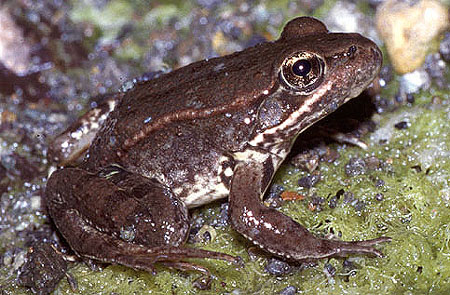- California Red-legged Frog
Taxobox | name = California Red-legged Frog
status = LR/nt | status_system = IUCN2.3
trend = down

image_width = 240px
regnum =Animalia
phylum =Chordata
classis =Amphibia
ordo =Anura
familia =Ranidae
genus = "Rana"
species = "R. draytonii"
binomial = "Rana draytonii"
binomial_authority = Baird & Girard, 1852
synonyms ="Rana aurora draytonii" Baird & Girard, 1852The California Red-legged Frog is a moderate to large (4.4-14 cm)
species offrog . It is nowadays known under the scientific name "Rana draytonii", after being long included ith theNorthern Red-legged Frog ("R. aurora") assubspecies of a single species called simplyRed-legged Frog . California red-legged frogs are nearly endemic to California, only leaving the State as they enter extreme northern Baja California. This species occurs most commonly along the Northern and Southern Coast Ranges, and in isolated areas in the foothills of the Sierra Nevada Mountains.Its back is brown, grey, olive or reddish color with black flecks and dark, irregular, light-centered blotches and is coursly granular. There is a dark mask with a whitish border above the upper jaw, and black and red or yellow mottling in the groin. The lower abdomen and the underside of its hindlegs are normally red. Males can be recognized by their enlarged forelimbs, thumbs, and webbing. Juveniles have more pronounced dorsal spotting, and may have yellow, instead of red markings on the underside of the hindlegs. A characteristic feature of the red-legged frog is its dorsolateral fold, which is visible on both sides of the frog extending roughly from the eye to the "hip." The California red-legged frog was listed as a threatened species by the United States Fish and Wildlife Service in 1996.
Ecology and behavior
It is estimated that this species has disappeared from 70% of its range and is now only found in about 238 streams or drainages in 23 counties of
California . Breeding occurs from November to March, however breeding has been recorded earlier in the southern limits of its range. This species inhabits dense, shrubby or emergent riparian vegetation associated with perennial and ephemeral water bodies that are still or slow moving water. This frogestivate s in small mammal burrows or under damp leaf litter. The California Red-legged Frog is an important food source for the endangeredSan Francisco Garter Snake .The tadpoles (larvae) of this species may metamorphose into frogs within several months of hatching from the egg, or may "overwinter". Transformation for overwintering tadpoles may take 13 months or more. Recent discoveries, such as overwintering, have management implications for this threatened species, particulalry when aquatic habitat under goes modification.
Human relations
After years of litigation initiated by land developers organizations, specifically the
Home Builders Association of Northern California , and scientific back-and-forth, the U.S. Fish and Wildlife Service announced in April 2006 the designation of about 450,000 acres (1800 km²) of critical California habitat for the threatened frog. This protected habitat did not include any land inCalaveras County , the setting ofMark Twain 's short story, "The Celebrated Jumping Frog of Calaveras County ", which features this species.On
17 September ,2008 , the US Fish and Wildlife Service proposed to more than triple the habitat of theCalifornia red-legged frog , citing political manipulation by former deputy assistant secretary at theUnited States Department of the Interior Julie MacDonald . According to the Los Angeles Times, "Development and destruction of wetlands have eliminated the frogs from more than 70% of their historic range. MacDonald would have reduced what was left of the frog's range by 82%." [http://www.latimes.com/news/printedition/california/la-me-frog17-2008sep17,0,731410.story A California frog may be about to get room to stretch its red legs] ]References
* (2005): Phylogeny of the New World true frogs ("Rana"). "Mol. Phylogenet. Evol." 34(2): 299–314. doi|10.1016/j.ympev.2004.10.007 [http://www.cnah.org/pdf_files/215.pdf PDF fulltext] .
* (2007) Constraints in naming parts of the Tree of Life. "Mol. Phylogenet. Evol." 42: 331–338.
* Database entry includes a range map and justification for why this species is near threatened
* This article is based on a description from "A Field Guide to the Reptiles and Amphibians of Coastal Southern California", Robert N. Fisher and Ted J. Case, USGS, http://www.werc.usgs.gov/fieldguide/index.htm.
* U.S. Fish and Wildlife Service, http://www.fws.gov/endangered/features/rl_frog/rlfrog.html
* [http://www.washingtonpost.com/wp-dyn/content/article/2006/04/30/AR2006043000400_2.html "Calif. Frog at Center of Protection Debate" "Washington Post"]ee also
*
Red-legged Frog
*Estivation
*Hickman's potentilla
Wikimedia Foundation. 2010.
